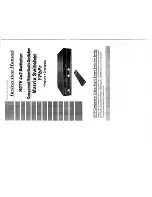
28. Spanning Tree
ROX™ v2.2 User Guide
303
RuggedBackbone™ RX1500
28.2.1. MST Regions and Interoperability
In addition to supporting multiple spanning trees in a network of MSTP-capable bridges, MSTP is
capable of interoperating with bridges that support only RSTP or legacy STP, without requiring any
special configuration.
An MST region may be defined as the set of interconnected bridges whose MST Region Identification
is identical. The interface between MSTP bridges and non-MSTP bridges, or between MSTP bridges
with different MST Region Identification information, becomes part of an MST Region boundary.
Bridges outside an MST region will see the entire region as though it were a single (R)STP bridge; the
internal detail of the MST region is hidden from the rest of the bridged network. In support of this, MSTP
maintains separate ‘hop counters’ for spanning tree information exchanged at the MST region boundary
versus that propagated inside the region. For information received at the MST region boundary, the
(R)STP Message Age is incremented only once. Inside the region, a separate Remaining Hop Count
is maintained, one for each spanning tree instance. The external Message Age parameter is referred
to the (R)STP Maximum Age Time, whereas the internal Remaining Hop Counts are compared to an
MST region-wide Maximum Hops parameter.
MSTI
An MSTI (Multiple Spanning Tree Instance) is one of sixteen independent spanning tree instances that
may be defined in an MST region (not including the IST – see below). An MSTI is created by mapping a
set of VLANs (in ROX™, via the VLAN configuration) to a given MSTI ID. The same mapping must be
configured on all bridges that are intended to be part of the MSTI. Moreover, all VLAN to MSTI mappings
must be identical for all bridges in an MST region.
ROX™ supports 16 MSTIs in addition to the IST.
Each MSTI has a topology that is independent of every other. Data traffic originating from the same
source and bound to the same destination but on different VLANs on different MSTIs may therefore
travel a different path across the network.
IST
An MST region always defines an IST (Internal Spanning Tree). The IST spans the entire MST region,
and carries all data traffic that is not specifically allocated (by VLAN) to a specific MSTI. The IST is
always computed and is defined to be MSTI zero.
The IST is also the extension inside the MST region of the CIST (see below), which spans the entire
bridged network, inside and outside of the MST region and all other RSTP and STP bridges, as well
as any other MST regions.
CST
The CST (Common Spanning Tree) spans the entire bridged network, including MST regions and any
connected STP or RSTP bridges. An MST region is seen by the CST as an individual bridge, with a
single cost associated with its traversal.
CIST
The CIST (Common and Internal Spanning Tree) is the union of the CST and the ISTs in all MST
regions. The CIST therefore spans the entire bridged network, reaching into each MST region via the
latter’s IST to reach every bridge on the network.
















































